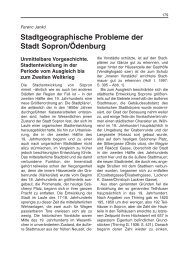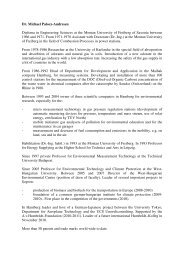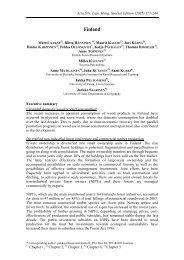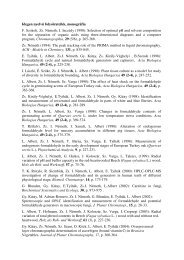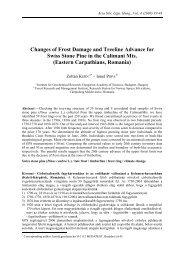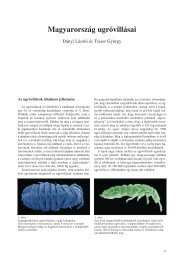PEDRON, Luca - PIVA, Giovanna - LA PORTA, Nicola
PEDRON, Luca - PIVA, Giovanna - LA PORTA, Nicola
PEDRON, Luca - PIVA, Giovanna - LA PORTA, Nicola
Create successful ePaper yourself
Turn your PDF publications into a flip-book with our unique Google optimized e-Paper software.
160<br />
Acta Silv. Lign. Hung. Spec. Edition, 2007<br />
Pedron, L. – Piva, G. – La Porta, N.<br />
olaszországi és görögországi S. cardinale izolátumtól. Az olasz izolátumok genetikai homogenitása<br />
arra utal, hogy a gomba nemrég palacknyak-hatáson ment át (egyedlétszáma erősen lecsökkent),<br />
valószínűleg néhány genotípusának európai behurcolása óta. Ez alátámasztja azt a hipotézist, hogy a<br />
gomba a második világháború során, fertőzött faanyaggal került be Európába az USA-ból. Az<br />
eredményeket a gomba európai behurcolása és terjedése vonatkozásában vitatjuk meg.<br />
Molekuláris markerek / Cupressus sempervirens / Seiridium cardinale / populációgenetika /<br />
genetikai változatosság / f a kórokozó<br />
1 INTRODUCTION<br />
The common cypress (Cupressus sempervirens L., Cupressaceae) has an important role in<br />
the characterization of Mediterranean landscape mainly for its aesthetic functions. This<br />
tree species grows under various Mediterranean climates (Emberger et al. 1963), from sea<br />
level up to 2000 m or more on a variety of soil types and in a variety of plant association<br />
(Zohary 1973).<br />
The cypress is an hardy tree which grows in most environmental conditions although it<br />
dislikes severe winter temperatures. Two varieties can be found, var. pyramidalis, the most<br />
used as ornamental, and var. horizontalis with its broader more irregular crown.<br />
Cypress has demonstrated to be an excellent pioneer species for reforestation of rocky,<br />
argillaceous, limestone, barren and superficial lands. It prevents the hydrogeological erosion<br />
and constitutes a source of yield for the good quality of its wood. It is also used like<br />
windbreak plant. The cypress., is native to Asia Minor and Persia and part of Greece, but<br />
nowadays it grows also along all Mediterranean basin: France, Spain, Portugal, former<br />
Yugoslavia and Italy as well as in North Africa (Teissier du Cros et al. 1999) where it was<br />
introduced presumably during the Roman era or even before, since the Phoenicians and<br />
Etruscans (Santini – Di Lonardo 2000, Giannelli – Bezzini 2002).<br />
Over the past half century a destructive blight of Cupressus spp., caused by Seiridium<br />
cardinale, has spread worldwide from North America, devastating forests, plantations, and<br />
ornamental cypresses. The epidemic has been particularly severe in the Mediterranean region,<br />
on C. sempervirens. Three species of Seiridium, S. cardinale, S. cupressi, and S. unicorne, are<br />
associated with cypress canker (Swart 1973, Chou 1989), even though S. cardinale seems to<br />
be the most dangerous in Europe on C. sempervirens.<br />
Great variation exists in the susceptibility of different species of Cupressaceae to<br />
S. cardinale infection (Andreoli 1979, Raddi 1979). Intraspecific variation in resistance<br />
has also been reported on C. sempervirens (Ponchet – Andreoli 1979, Xenopoulos 1990,<br />
1991), with marked variations within provenances and families from controlled crosses<br />
(Graniti 1998).<br />
The low temperatures, that the cypress has often to stand in the Northern area of the<br />
species distribution, act indirectly to increase the strength of penetration of S. cardinale<br />
spores by means of microlesions created by frost (Teissier du Cros et al. 1999). Several<br />
cypress improvement programs for resistance to canker and cold were set up with the attempt<br />
to cultivate resistant clones throughout wide-reaching territories and areas with highly diverse<br />
pedoclimatic conditions (Santini – Di Lonardo 2000, La Porta et al. 2004).<br />
The possibility that, despite its cold susceptibility, future climate changes may render the<br />
North of Italy more favourable to cypress cultivation could aid the increasing spread of this<br />
arboreal plant on the amenities and encourages studies on the acclimatation of this conifer in<br />
the Italian northern regions (La Porta et al. 2004).<br />
Effective exploitation of the cypress genetic resistance sources may enable the<br />
replacement of stands damaged by canker and by cold with more resistant selections.





